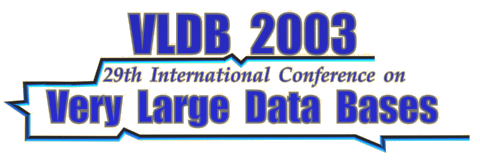| It
is the author's responsibility to make the paper readable,
relevant and interesting before submission for consideration
by referees. This includes legibility of diagrams and quality
of English. |
| Duplicate
submissions are not allowed for VLDB conferences. A VLDB conference
submission is considered to be a duplicate submission if there
is another paper with all of the following properties: |
1.
the paper and VLDB submission have at least one author in
common;
2. the paper is more than 4 pages long, when formatted for
the VLDB Proceedings;
3. the main technical content of the paper substantially overlaps
that of the VLDB submission;
4. the paper is published or under consideration to be published
in a refereed journal or proceedings (electronic or printed)
that is generally available (e.g., not limited to conference
attendees). |
| Authors
submitting papers to VLDB conferences are expected to agree
to the following terms: |
| "I
understand that the paper being submitted must not contain
substantial overlap with any other paper currently submitted
elsewhere. Furthermore, previously published papers with any
overlap are cited prominently in this submission." |
| Duplicate
submissions will be rejected. Questions about this policy
or how it applies to your work should be directed to the technical
program chairperson, Johann-Christoph
Freytag (freytag@dbis.informatik.hu-berlin.de). |
| Once
a research paper has been prepared, the authors must register
their intention to submit it by recording the abstract at
the research paper submission site by
11 February
2003 (9:00 p.m. Pacific Standard Time).
By doing so, authors obtain a reference number that will be
used to identify the paper during refereeing. Without a registered
abstract, papers may not be processed correctly. |
| When
the abstract is registered, the submission site will also
solicit information about the contact author. This information
will be used for VLDB administration purposes (e.g., to notify
authors of the outcome of the submission). If an author has
to change the contact information, he or she should e-mail
the area program chair. This is a manual procedure, so please
choose contact information that will be stable over the period
of paper processing.
|
| Papers
must be electronically submitted. Authors are responsible
for ensuring that the submitted material is on time (no extensions
will be given) and complies with the size constraints (long
papers will not be refereed). Every paper should have a cover
page (not counted in the page count) that:
|
- Identifies
the contact author.
- Gives
his or her address for correspondence (e-mail, conventional
mail and telephone).
- States
the reference number (see Registering an Abstract).
- Indicates
the topic area ("core database technology" or
"infrastructure for information systems") and
the category ("research" or "vision").
- Gives
the title and full list of authors (marking any author
that is on any VLDB 2003 program committee).
- Indicates
the topics relevant to the paper, selected among those
present in this topic list.
|
| This
cover page is redundant information if the abstract has been
registered using the database as requested (see Registering
an Abstract). However we would like this extra information
to simplify the administrative processing of your paper.
|
| Papers
must be in PDF. It is essential that they print without difficulty
on a variety of printers using Adobe Acrobat Reader. Therefore,
authors must be sure that any special fonts are included,
etc. It is the absolute responsibility of the authors to ensure
that their submitted paper is in PDF and will print easily.
Authors must upload the PDF of papers to the research paper
submission site by 18 February 2003 (9:00 p.m. Pacific
Standard Time). The file must be named by the reference
number allocated when the abstract was submitted (e.g., 789.pdf;
see Registering an Abstract). |
| |

